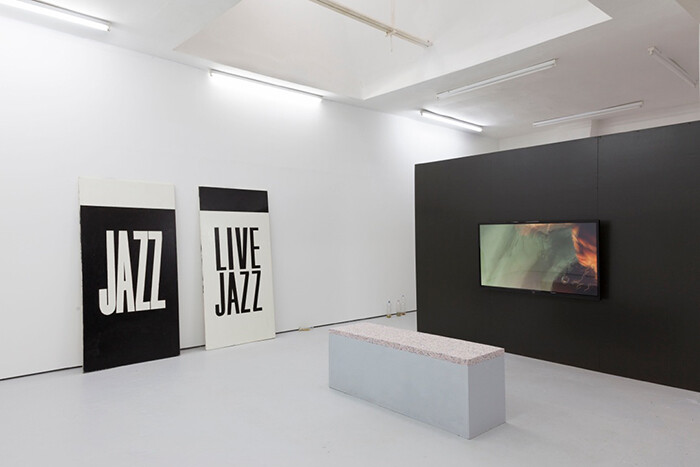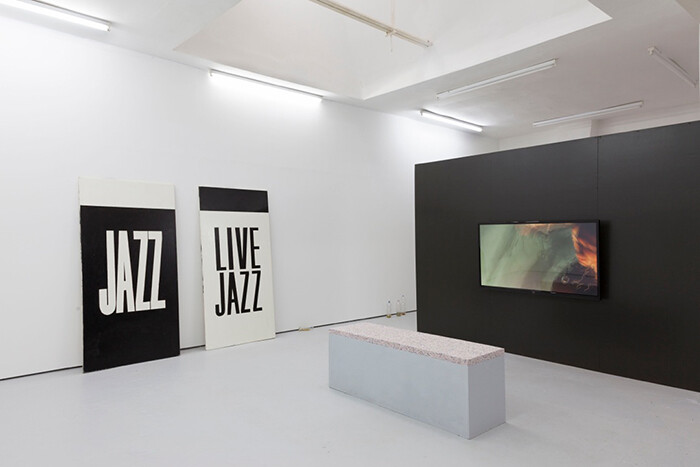Sasha Litvintseva’s beautifully observed short film Alluvion (2014) follows a group of three tourists as they meander around an unidentified city against the backdrop of daily life: where women and children take their exercise in an open-air gym and laborers hammer away in a shipbuilding workshop. Litvintseva describes, ominously, how “the film and the world around them all are disintegrating toward an Atlantean End”(1), suggesting an equivalence between the lifespan of the film and the world around it. Rather than science fiction, her tale might be closer to the factual present, just as our lives—lived more than ever through digital screens—inch closer to becoming a moving image version of Argentinian author Jorge Luis Borges’s proposal to make a map “the scale of a mile to the mile” in his single-paragraph short story “On Exactitude in Science” (1946). Ultimately, Borges faults cartography’s gradual lack of precision for its failure to achieve this ideal. However, today we have begun to relate to the internet in the same way, taking it for granted much like the weather or time. Indeed, many of the eight participating artists in “World Music”—the current exhibition at Carlos/Ishikawa in London—were born in the late 1980s, and therefore grew up with the internet, never feeling the anxiety of separating their online lives from life itself.
The exhibition’s title is deliberately misleading because the exhibition has little to do with music, and also the term “world music” has been used to describe an entire genre that completely ignores the specificity of a diverse range of musical styles. By appropriating this less than serious descriptor, the two artists who have organized the show—Steve Bishop and Richard Sides—strategically undermine their temporary role as curators, allowing the works on view to make much bolder and irreverent gestures. Ultimately, the show signals a return to form with many of its artists seeking to develop a visual language that transcends the properties of any given medium or genre.
Renaud Jerez’s two anthropomorphic sculptures, both No Title (2014), for example, have an enigmatic character that emerges from a collision of different media. Reduced in form to mummified circuits of tubing, one sits poised on an office chair and the other lies collapsed on a crudely constructed bed. Loosely clothed in custom-made sportswear, immaculate trainers, and high fashion platform shoes, their wiry forms seem somewhat animate. These are the catwalk alternatives to Atelier van Lieshout’s Technocrat (2003), a dystopian vision of humans as components of machines or “biological cogwheels,” plugged in at both ends and lending their digestive systems to the production process. Both artists’ works are at once removed and entirely symptomatic of our contemporary condition. In our almost entirely abstracted digital economy, Jerez’s charred figures can be recognized as portraits of surplus value: they represent exhausted authenticity, or “hype” incarnate.
If Jerez’s vestigial figures are the by-products of our increasingly intangible materialism, then perfume would be its vaporous scent. Richard Parry’s diptych, Jazz/Live Jazz (2009), is a flatly celebratory reference to the iconic packaging of two homonymous Yves Saint Laurent fragrances; the two oil paintings are installed side-by-side as they lean against a wall. Like Jerez’s seated and prostrate works, the sense of the paintings’ physical gravity is immediately apparent, drawing a symbolic distinction with Andy Warhol’s prolific screen-printing of more low-brow, household brands. On smaller canvases, Parry’s impressions of dancing silhouettes inspired from the original advertising of the perfume comically serve as “ethnic art,” connecting jocularly to the theme of the exhibition.
Vittorio Brodmann’s colorful painting Wer Geburstag hat, kann sich freuen [On your birthday you can be happy] (2012) is hung on a tarry gloss, black wall. Two cartoon-like caricatures are depicted, one on top of the other: a gangly teenager with one big ear listening to a Walkman and, in the scene below, a harried-looking businessman, using his phone and his laptop while sitting at a table with a cup of coffee beside him. Brodmann’s images are naïve, but the subtle emphases and disjunctures he makes between meaning and expression clearly speak to a viewership conditioned to the slow evolution of reality TV and online newsfeeds with a heightened awareness of any change in detail, intimated or projected.
Overall, as one walks through “World Music,” the show takes on a multifaceted character, generating meaning that is porous and subjectively experienced. This can be seen in Stuart Middleton’s piss bottles and comic book-style slideshow Worm (both 2014)—narrated from the perspective of a tapeworm—which visualize the illicit novels of American authors like Charles Bukowski (1920–1994) and Denis Cooper (b. 1953). Similarly, Louisa Gagliardi’s inkjet prints The Hand and The Card Players (both 2013) are skillful computerized embodiments of Paul Cézanne’s The Card Players (c. 1890), while The Bathers (2013) makes reference to Giorgio de Chirico’s “Mysterious Baths” series from 1935–36. Enabling the audience to experience affinities between the works both physically and intuitively, the show’s emphasis on form reasserts the material presence of the objects within the gallery space.
1) Sasha Litvintseva, “Alluvion,” http://sasha-litvintseva.com/films.











